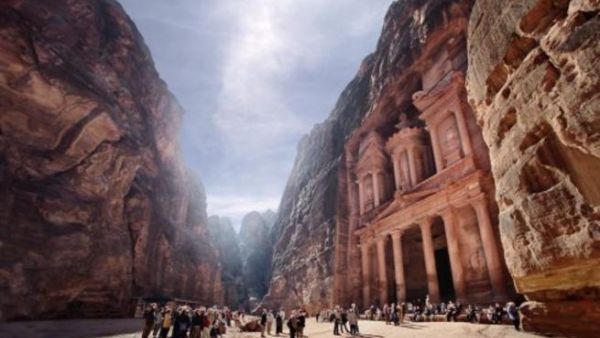Jordans recently unveiled five-year national tourism strategy (NTS) foresees the private sector playing a growing role in the sector, with the eventual goal of doubling the industrys contribution to the gross domestic product (GDP).
The tourism sectors contribution to the GDP reached 12.4 percent in 2010. According to the NTS 2011-15, the government estimates that the public sector will spend JD152 million ($215.5 million) and the private sector will spend JD38 million ($53.6 million) over the five-year period.
Jordan will continuously work on creating a more supportive business environment to enable successful investments in the tourism sector, as Jordan has great potential which investors can help us reach, and we, in return, can help investors reach their potential and contribute to economic prosperity, said Haifa Abu Ghazaleh, the minister of tourism and antiquities, at the plans unveiling in early August. The NTS 2011-15 builds on the foundation laid for the sector by first tourism development plan, the NTS 2004-10, which was based on four main pillars guiding growth and development.
The NTS 2011-15 keeps the same four-pillar framework, though the focal points have been slightly amended to reflect the success of the previous plan and current goals. The first pillar of the NTS 2011-15 is marketing and promotion, which is where the government plans to increase its efforts in social and digital media to attract new, higher-yielding markets.
The goals set out under this pillar for 2011-15 include increasing tourist arrivals to 9.4 million, boosting overall tourism receipts to JD4.2 billion ($5.9 billion) and growing domestic receipts by 30 percent. This would continue the significant progress made between 2004 and 2010, which saw tourism arrivals increase from 5.6 million in 2004 to 8.2 million in 2010 and tourism receipts rise 247 percent, from JD943 million ($1.3 billion) to JD2.42 billion ($3.4 bilion).
The NTS 2004-10 also saw improvements in hotel capacity and tourism infrastructure: 24 new hotels were built, increasing the number of hotel rooms by 22 percent. Additionally, the number of tourist restaurants almost doubled and the number of tour guides grew by nearly 60 percent, according to the NTS 2011-15. As a result of this success, the NTS second pillar, product development, focuses on continuing expansion in new hotel capacity and large-scale developments. This pillar aims to see air capacity into Jordan increased by 20 percent, 20 new tourism infrastructure projects completed, and 100 percent of hotels and 80 percent of restaurants approved and ranked under the national classifications scheme. In line with this, the public-private partnership project to develop and expand the Queen Alia International Airport (QAIA) will be vital. The number of passengers transiting through QAIA jumped 23.5 percent in the first half of 2011, reaching 485,000, compared to 392,000 in the same period of 2010.
The opening of an $800 million terminal next year is expected to attract more transit passengers. A well-educated and highly skilled workforce will be needed as well, and the NTS 2011-15s third pillar, labour market development, reflects this. After having seen direct employment in tourism increase by 85 percent between 2004 and 2010, the government aims for the sector to create 25,000 additional jobs directly and more than 500,000 indirectly by 2015.
Finally, the NTS 2011-15s fourth pillar, enabling environment, aims to increase the functionality of the sector at large by passing a new tourism law, developing new tourism policies and increasing awareness among key stakeholders of the benefits of sustainable tourism. But Jordan will have to catch up quickly to meet the NTS 2011-15s goals, as performance in the first half of 2011 fell short of expectations.
The sectors earnings during the first six months of the year amounted to JD949 million ($1.3 billion), down from the JD1.09 billion ($1.5 billion) in the first half of 2010, according to statistics from the Ministry of Tourism and Antiquities released in August. Some 3.12 million tourists visited Jordan between January and June, compared to the 3.64 million who visited over the same period in 2010. The 14.2 percent drop was largely attributed to regional political unrest, which led to numerous cancellations, despite the limited local effects.
Increasing private sector investment will be key to achieving the NTS goals. But though travel and tourisms total contribution to Jordans GDP, at 20.3 percent in 2011 according to the World Travel & Tourism Councils 2011 Jordan report, is far higher than the Middle East region as a whole, which stood at 8.1 percent of the GDP, Jordan lags behind other countries - including Egypt, Turkey, Lebanon and Syria - in terms of foreign investment. The World Travel & Tourism Council estimates travel and tourism investment in Jordan in 2011 will total JD418.2 million ($590.2 million), or 8.7 percent of total investment, increasing 3.9 percent per year until 2021 to reach JD613.4 million ($865.7 million), which in current 2011 prices will account for 8.4 percent of projected GDP.
However, Jordan does offer investors several advantages over its regional counterparts: The Kingdom is politically stable, boasts a wealth of archaeological and historical sites, and has a long and storied history.
And if recent events are anything to go by, the governments plans for public-private cooperation are already coming into effect: The King Abdullah II Fund for Development, a non-governmental funding scheme set up by the King, is considering helping to finance a $1.5 billion Star Trek theme park, modelled on the cult American sci-fi series, in Aqaba. Jordans Rubicon Group Holding announced the plan in August and said the project was backed by private investors from the US and the Gulf. Oxford Business Group (OBG) is a highly acclaimed global publishing, research and consultancy firm, which published economic and political intelligence on the markets of Asia, Eastern Europe, the Middle East, and North and South Africa.








